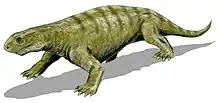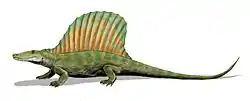| Tetraceratops Temporal range: Early Permian, | |
|---|---|
 | |
| Holotype | |
| Scientific classification | |
| Domain: | Eukaryota |
| Kingdom: | Animalia |
| Phylum: | Chordata |
| Clade: | Synapsida |
| Clade: | Pantherapsida |
| Genus: | †Tetraceratops Matthew, 1908 |
| Type species | |
| †Tetraceratops insignis Matthew, 1908 | |
Tetraceratops insignis ("four-horned face emblem") is an extinct synapsid from the Early Permian that was formerly considered the earliest known representative of Therapsida, a group that includes mammals and their close extinct relatives.[1][2][3] It is known from a single 90-millimetre-long (3.5 in) skull, discovered in Texas in 1908. According to a 2020 study, it should be classified as a primitive non-therapsid sphenacodont rather than a genuine basal therapsid.[4]
Description
Tetraceratops is known from a single 90-millimetre-long (3.5 in) skull discovered in Texas in the early 1900s. Contrary to its genus name, Tetraceratops actually has six horns, one pair being on the premaxilla bones, one pair on the prefrontal bones, and one pair on the angular processes of the mandible. When it was discovered and described in 1908, the skull was still embedded in a matrix, and only the premaxilla and prefrontal pairs were visible. In life, thus, it would have resembled a large lizard with four horns on its snout, and a pair of large spines emanating from the corners of its jaw.
In addition to horns, Tetraceratops also had an impressive set of teeth. The second pair of teeth on the maxillary bones were large and fang-like. Likewise the first teeth in the upper jaw were long and dagger-like.

Classification
Tetraceratops was originally identified as a member of a group called Pelycosauria, an evolutionary grade of synapsids more basal than therapsids. It has been variously grouped in the family Sphenacodontidae, which is closely related to Therapsida, and Eothyrididae, which is more distantly related. Recent phylogenetic studies classify it as either a pelycosaur-grade synapsid or the basalmost therapsid, rendering its exact phylogenetic placement unclear.[3][5][6][7] However, a new study by Spindler (in press) concluded that no convincing morphological evidence could be made for a therapsid placement of Tetraceratops and that this genus was better placed as a basal sphenacodontian.[4]
See also
References
- ↑ Laurin, M.; Reisz. R. R. (1996). "The osteology and relationships of Tetraceratops insignis, the oldest known therapsid". Journal of Vertebrate Paleontology. 16 (1): 95–102. doi:10.1080/02724634.1996.10011287.
- ↑ D. W. Dilkes, R. R. Reisz (1996). "First Record of a Basal Synapsid ('Mammal-Like Reptile') in Gondwana". Proceedings of the Royal Society B. 263 (1374): 1168. doi:10.1098/rspb.1996.0170.
- 1 2 Amson, E.; Laurin M. (2011). "On the affinities of Tetraceratops insignis, an Early Permian synapsid". Acta Palaeontologica Polonica. 56 (2): 301–312. doi:10.4202/app.2010.0063.
- 1 2 Spindler, Frederik (2020). "The skull of Tetraceratops insignis (Synapsida, Sphenacodontia)" (PDF). Palaeovertebrata. 43 (1): e1. doi:10.18563/pv.43.1.e1.
- ↑ Sidor, C. A.; Hopson, J. A. (1998). "Ghost lineages and "mammalness": assessing the temporal pattern of character acquisition in the Synapsida". Paleobiology. 24 (2): 254–273. doi:10.1666/0094-8373(1998)024[0254:GLAATT]2.3.CO;2. JSTOR 2401242.
- ↑ Conrad, J.; Sidor, C. A. (2001). "Re-evaluation of Tetraceratops insignis (Synapsida: Sphenacodontia)". Journal of Vertebrate Paleontology. 21: 42A. doi:10.1080/02724634.2001.10010852. S2CID 220414868.
- ↑ Liu, J.; Rubidge, B; Li, J. (2009). "New basal synapsid supports Laurasian origin for therapsids". Acta Palaeontologica Polonica. 54 (3): 393–400. doi:10.4202/app.2008.0071.







.jpg.webp)